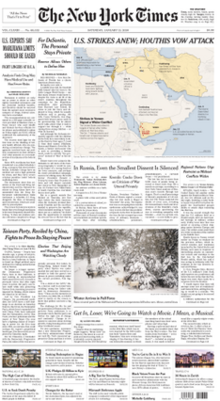News Articles - The Facts
The Best Strategy To Use For News Articles
Table of ContentsThe Best Strategy To Use For News ArticlesUnknown Facts About News ArticlesThe Greatest Guide To News ArticlesNews Articles for DummiesRumored Buzz on News Articles
Good knowledge of different topics offers students an affordable side over their peers. Although electronic and social networks are easily obtainable, we ought to not neglect how crucial it is to review the newspapers. Moms and dads need to try and instill the routine of reading a paper as an everyday routine to continue the legacy of the revered print medium.Information stories likewise consist of a minimum of one of the adhering to essential features about the desired audience: closeness, prestige, timeliness, human passion, peculiarity, or repercussion. The related term journalese is occasionally made use of, normally pejoratively, to refer to news-style writing. One more is headlinese. Papers normally stick to an expository writing style.
Within these restrictions, information stories likewise intend to be comprehensive. Amongst the bigger and extra highly regarded papers, fairness and equilibrium is a major element in offering information.
Newspapers with a global audience, for example, have a tendency to utilize an extra official design of writing. News Articles.; typical design overviews consist of the and the US News Design Publication.
News Articles - Truths
As a regulation, journalists will certainly not use a long word when a brief one will certainly do. News writers attempt to avoid utilizing the very same word much more than as soon as in a paragraph (sometimes called an "resemble" or "word mirror").
Nevertheless, headlines in some cases leave out the subject (e.g., "Jumps From Watercraft, Catches in Wheel") or verb (e.g., "Pet cat woman lucky"). A subhead (also subhed, sub-headline, subheading, caption, deck or dek) can be either a subservient title under the major headline, or the heading of a subsection of the short article. It is a heading that comes before the primary message, or a group of paragraphs of the major message.

Added billboards of any of these types may show up later in the post (specifically on succeeding web pages) to lure more reading. Such billboards are additionally utilized as pointers to the short article in other sections of the magazine or site, or as advertisements for the item in various other publication or sites. Normal structure with title, lead paragraph (recap in vibrant), other paragraphs (information) and contact information.

Instance of a hard-lead paragraph NASA is suggesting another space task. The agency's budget plan demand, introduced today, included a plan to send one more goal to the Moon. This time around the company intends to develop a long-lasting center as a jumping-off point for other area experiences. The spending plan requests around $10 billion for the project.
An "off-lead" is the 2nd most vital front web page information of the day. To "hide the lead" is to start the post with history information or details of second value to the readers, forcing them to check out more deeply right into a post than they need to have to in order to find the crucial points.
Indicators on News Articles You Should Know
Common use is that one or more sentences each form their very own paragraph. Reporters normally describe the company or structure of an information tale as an upside down pyramid. The essential and most intriguing components of a tale are placed at the beginning, with sustaining info adhering to in order of decreasing relevance.
It allows people to discover a subject to just the deepness that their interest takes them, and without the imposition of details or nuances that they might consider unnecessary, however still making that details readily available to more interested visitors. The upside down pyramid framework additionally makes it possible for short articles to be trimmed to any type of approximate size during layout, to fit in the space offered.
Some authors start their stories with the "1-2-3 lead", yet there are many sort of lead readily available. This format inevitably starts with a "5 Ws" opening up paragraph (as described above), complied with by an indirect quote that offers to sustain a significant component of the very first paragraph, and after that a straight link quote to sustain the indirect quote. [] A kicker can describe multiple things: The last tale in the information program; a "happy" story to end the program.
Longer short articles, such as magazine cover articles and the items that lead the inside sections of a paper, are known as. Feature stories differ from straight information in a number of methods.
Rumored Buzz on News Articles
The reporter commonly information communications with meeting subjects, making the piece extra personal. An attribute's first paragraphs commonly connect an interesting minute or event, as in an "anecdotal lead". From the details of an individual or episode, its sight quickly expands to generalities regarding the tale's topic. The section that signifies what a feature is about is called the or signboard.

The Editor's Tool kit: A Referral Guide for Beginners and Professionals (2001) Allan M. Siegal and William G. Connolly. The New York Times Guidebook of Style and Usage: The Authorities Design Overview Made Use Of by the Writers and Editors of the Globe's Most Authoritative Newspaper (2002) M. L. Stein, Susan Paterno, and R.